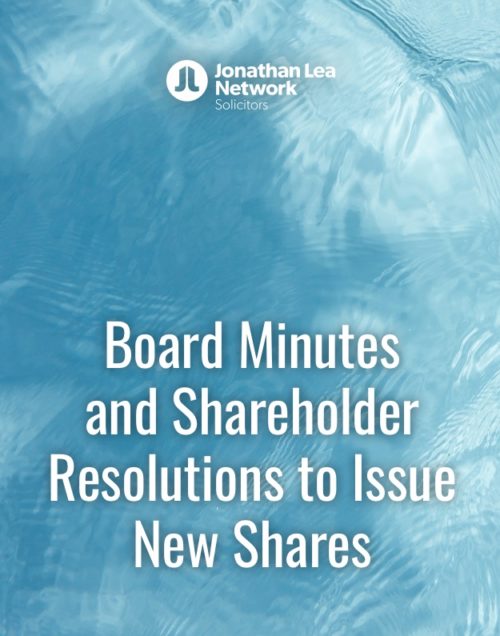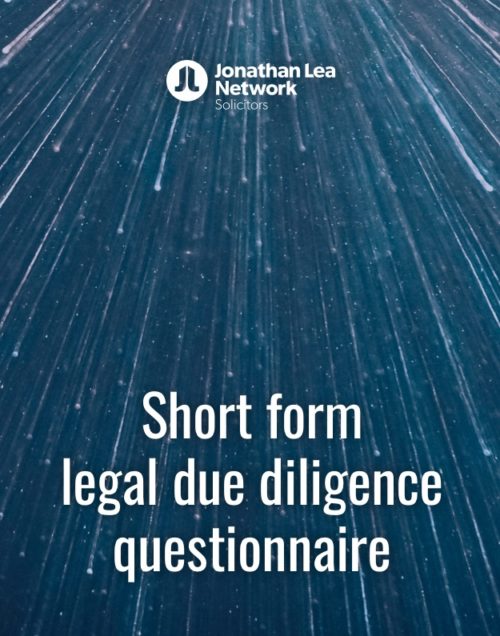Pre-Emptive Offer Letter
£12.99
This product constitutes an easily adaptable pre-emptive offer letter which can be used in order to facilitate the company raising money from its existing shareholders, together with guidance notes to assist you with filling out the pre-emptive offer letter template. The guidance notes also briefly explain what statutory pre-emption rights are and sets out the procedure that must be followed in order for a company to legally make a pre-emptive offer to its existing shareholders (in line with the relevant provisions in the Companies Act 2006).
We have kept the template as simple as possible and it will therefore not be relevant to every scenario. The template will need to be adapted depending on the company and the circumstances of each case and further detail will need to be added for example if the statutory pre-emption rights have been varied by a shareholders agreement or within the company’s articles of association. In such a case, the letter will need to make references to the relevant provisions within those documents instead.
The only drafting that needs to be done from your side is to insert the relevant information into the square brackets (where your input is required has been highlighted in yellow). The wording inside the square brackets which we have included explains clearly the information that should be inserted. You are advised to fill in the wording in square brackets in lower case. Any figures should be entered in numerical form. The brackets should be removed after the amendments are made (so as to produce a ‘final form’ version of the pre-emptive offer letter to be sent to the company’s existing shareholders).
Guidance notes for template pre-emptive offer letter
The template pre-emptive offer letter can be used by a company that is thinking about issuing new shares and raising investment (from its existing shareholders initially, but should they fail to subscribe for their entitled proportion of new shares then from third party investors). It can also be used in circumstances where the company has issued new shares and raised monies via this method previously, and wishes to issue further shares and raise additional funds.
Note importantly that this template letter includes references to the relevant provisions relating to pre-emption rights contained within the Companies Act 2006 (“Act”). Where these statutory pre-emption rights have been varied by a shareholders agreement or within the company’s articles of association, the letter will need to refer to the relevant provisions within those documents instead.
To give the letter context, it is worth briefly explaining what statutory pre-emption rights are. In circumstances where a company is allotting / issuing new shares, pre-emption rights effectively give existing shareholders a right of first refusal in relation to the new shares (to be allotted / issued). Therefore, a right of pre-emption is an anti-dilution mechanism that allows shareholders to preserve their percentage shareholding in a company, provided of course that the shareholder has sufficient funds available to be able to take up their rights and subscribe for new shares.
The basic principle underpinning the statutory pre-emption rights contained within the Act is that a shareholder should be able to protect his or her shareholding from being diluted and this is facilitated by giving shareholders the opportunity to subscribe for a proportionate part of any new shares that are issued by the company.
This principle is enshrined in section 561 of the Act, which requires that a company proposing to allot “equity securities” (these are defined in section 560 of the Act as including both ordinary shares and rights to subscribe for, or to convert securities into, ordinary shares) must first offer them on the same or more favourable terms to each holder of ordinary shares pro rata to his / her existing shareholding.
The offer made to the company’s shareholders must comply with the requirements as set out in sections 561 and 562 of the Act. Where section 561 applies, the pre-emptive offer must be made to each person who holds ordinary shares in the company (section 561(1) (a)). The definition of ordinary shares for this purpose does not include preference shares (i.e. shares which carry limited rights to income and capital participation). Consequently, the holders of such preference shares will not be allowed to participate in a pre-emptive offer of new shares (nor are holders of debt securities, even where those debt securities are capable of being converted into ordinary shares).
Section 561(1) (a) of the Act provides the authority that the terms of the pre-emptive offer must be the same or more favourable than the subscription terms to be offered to third parties.
Section 561(1) (a) of the Act also provides that the proportion of the new equity securities offered to each of the ordinary shareholders must be equal (as nearly as is practicable) to the proportion in nominal value held by him or her of the ordinary share capital of the company.
As stated in the template letter, the pre-emptive offer may be made in hard copy or electronic form (section 562(2) of the Act).
Where a shareholder:
- has no registered address in the EEA and has not supplied the issuing company with an address in the EEA for the services of notices on him; or
- is a holder of share warrants issued pursuant to section 779 of the Act,
then section 562(3) of the Act provides that the offer may also be made by publication of a notice in the London Gazette.
As also stated in the template letter, the pre-emptive offer must specify an acceptance period which cannot be less than 14 days from the date on which the offer is sent or published by the company (in accordance with section 562(5) of the Act).
The company will be prohibited from allotting any shares that are subject to the statutory pre-emption rights procedure until the specified acceptance period has expired, or (if earlier) an acceptance or refusal of the offer has been received from every recipient (section 561(1) (b) of the Act).
The recipient can of course revoke his or her right to allotment and the company can then allot those equity securities to any third party to whom the right has transferred (section 561(2) of the Act).
Letter guidance
Your input is required at the parts of the letter highlighted in yellow and the wording inside the square brackets which we have included explains clearly the information that should be inserted. You are advised to fill in the wording in square brackets in lower case. Any figures should be entered in numerical form. The brackets should be removed after the amendments are made (so as to produce a ‘final form’ version of the pre-emptive offer letter.
The shareholder’s residential address should be inserted in the top left-hand corner and the date should be inserted in the second set of square brackets. It is worth noting that the same date should be inserted on every pre-emptive offer letter sent out to the company’s existing eligible shareholders.
The company’s name should then be inserted – this should be the name that the company is registered with at Companies House (as opposed to any trading name it operates under). If the company does have a trading name then you could consider putting the company’s registered name followed by “(trading as [INSERT TRADING NAME])”.
In the left-hand column of the table, you should insert the name of the shareholder to which the pre-emptive offer letter is addressed. In the top middle column of the table, you should set out how many shares the existing shareholders hold in aggregate between them.
For example, say the Company in question is Company X, it has 1000 ordinary shares of nominal value £0.10 each in issue, held by ten different shareholders in equal proportions (i.e. each shareholder holds 100 ordinary shares of nominal value £0.10 each). Propose that this pre-emptive offer letter has been addressed to Mr A. In the top middle box of the table, you would insert 900 as the number of shares held in aggregate between the existing shareholders other than Mr A, and in the bottom middle box you would insert 100 as the number of shares held by Mr A (given that he holds 10% of the Company’s 1,000 issued ordinary shares).
In the right-hand column of the table, you should insert the respective percentage shareholdings of the existing shareholders and of the shareholder to which the letter is addressed. Using the example of Company X given above, the percentage you would insert in the top right-hand box would be 90%, and the percentage you would insert in the bottom right-hand box would be 10%.
The completed table would look as follows in the case of Company X:
| Number of shares | Percentage of Company | |
|
Existing Shareholders
|
900 |
90% |
|
Mr A
|
100 |
10% |
In the first paragraph under the ‘Offer’ section of the template letter, in the first set of square brackets you should insert the total number of new ordinary shares that the company in question intends to issue. Using the example of Company X, say that they want to issue 10,000 new ordinary shares of nominal value £0.10 each (the £0.10 is the figure that you should insert in the second set of square brackets in this paragraph). Propose further that the subscription price is going to be £5.00 per share, so as to allow Company X to raise a total of £50,000 (you arrive at the £50,000 figure by taking the subscription price per share and multiplying it by the number of shares the company wishes to issue – i.e. 5 X 10,000 = 50,000).
Using the example of Company X given above, the first paragraph under the ‘Offer’ section of the template letter would read as follows:
“The Company intends to issue a further 10,000 new ordinary shares of nominal value £0.10 each (“New Shares”) at a subscription price of £5.00 each share (“Subscription Price”) in order to raise a total amount of £50,000 in subscription monies to be invested exclusively in the Company’s business”.
As these guidance notes explain, the Act provides that the proportion of the new equity securities offered to each of the ordinary shareholders must be equal (as nearly as is practicable) to the proportion in nominal value held by him or her of the ordinary share capital of the company.
Using Mr A as an example, he owns 10% of the company’s ordinary shares. His statutory pre-emption rights therefore entitle him to 10% of the 10,000 new ordinary shares that Company X is proposing to issue (i.e. Mr A is entitled to 1,000 of the 10,000 new ordinary shares). The total subscription price will be the total number of the new ordinary shares Mr A is entitled to (1,000) multiplied by the subscription price (£5.00). If Mr A exercises his pre-emption rights and applies for all of the shares he is entitled to, he will retain his 10% shareholding in Company X (provided of course he has the funds to purchase the new shares).
Using Mr A and Company X as an example, the second paragraph under the ‘Offer’ section of the template letter would read as follows:
“In accordance with our statutory obligations, we therefore offer you the opportunity to subscribe for 1,000 of the New Shares at a total subscription price of £5,000 in order to maintain your current 10% interest in the Company’s share capital (“Offer”). You can choose to apply for some or all of the shares (at the Subscription Price per share) pursuant to this Offer, or in the alternative you can choose not to apply for any of the proportion of the New Shares that you are entitled to (and revoke / renounce your right to allotment in accordance with section 561(2) of the Act in the process).
Under the ‘Acceptance’ section of the letter, at point a), you must set out the designated email address to which the shareholders can send their acceptance (this could be a company secretary’s email address, a generic company email address or a designated director’s email address).
At point b), you should insert the subscription price (which in Company X’s case would be £5.00), and you should also insert the company’s bank account details to which the shareholders can pay the subscription monies.
You will see that the template letter confirms that if the shareholder to whom the pre-emptive offer letter is addressed is unable or unwilling to accept the offer, then the new shares will be issued to new investors (i.e. third-party investors) who are prepared to invest the required funds in the company. If this were to happen, the shareholders’ holding would be diluted and the letter explains this and gives them notice of this fact (so as to avoid the situation where a shareholder refuses to accept a pre-emptive offer to subscribe for new shares and consequently has their shareholding diluted, and then later complains that they were not aware of the consequences).
Finally, at the end of the letter, there is space for the letter to be signed by a director, company secretary, CEO or whomever you choose.
We would be happy to review any pre-emptive offer letter which you produce in accordance with this template for a small fee. Otherwise, we hope that these guidance notes are sufficient to enable you to issue statute compliant pre-emptive offer letters to your shareholders and begin or continue raising money for your company.









